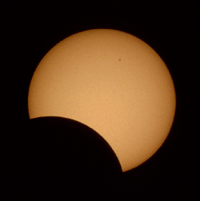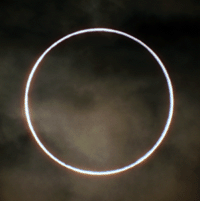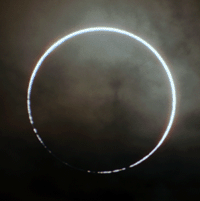
 |
For the 'Hybrid Eclipse' we travelled to Panama, with TravelQuest, where the eclipse was annular. |
| Site
Location (WGS 84) Longitude: 79 deg. 57 min. 12.8 sec. West Latitude: 8 deg. 57 min. 12.8 sec. North Predicted
Contact times (mean limb) The solar eclipse of 2005 April 8 was unusual in being of the ‘hybrid’ type: annular at the start and end of the track and total in the middle. Linda and I decided to try to view the eclipse in its annular phase from Panama. We joined a tour organised by the American travel company TravelQuest in association with Sky and Telescope. Panama is a fascinating country and in the days before the eclipse we were able to have a good look around. The first hotel we stayed at overlooked the canal by the Bridge of the Americas, which links South to North America and marks the point where the canal joins the Pacific Ocean. To sit on the balcony watching huge ships pass by, whilst drinking G & T’s is to say the least, an interesting experience. To maintain enough water in the canal to allow continuous passage of ships, requires the Panamanians to preserve their rainforest, which drains into the canal in the centre of this narrow country. The day before the eclipse found us travelling up river in motorised ‘canoes’ to visit a tribe who have chosen to live in a traditional maner in the heart of the rainforest. Whilst we were being entertained, the river which had been placid during our journey there, suddenly started to flow much more rapidly; the level rose quite dramatically and large branches and lumps of wood began to float past the village. At this location we were outside the zone of annularity and with the local tribesmen not prepared to venture out with their boats and return us to our coach, there was some concern that we might miss the eclipse! However, after a couple of hours, the river, although still flowing at a fast rate, had washed most of the debris downstream and had subsided enough to allow us to get out. The journey back downstream was considerably quicker than our earlier one upstream, and although not quite in the same league as white water rafting, was certainly exciting enough. Eclipse day was hot, humid and overcast at our hotel in the rainforest, but the eclipse site was some distance away so fingers were crossed. As our coach took us back through Panama City, across the Bridge of the Americas and to the south-west along the Transamerica highway, the cloud broke up and the Sun appeared. Being towards the end of the track meant that the eclipse would occur late afternoon in the western sky. The site chosen by Paul Deans of Sky and Telescope, was near the Pacific coast at a new resort not far from the town of Coronado. Our cameras and telescopes looked out across the incomplete golf course: the fairways and greens were laid out, but as yet there was no grass, just sand! It was touch-and-go with the weather, but the clouds were sufficiently broken and thin enough to allow us to see about half of the eclipse. There was a good display of Baily's Beads at second and third contact, and as we were almost on the centre line, we saw an unbroken ring of sunlight around the Moon for about 8 seconds. Shortly after third contact, the Sun disappeared for the rest of the evening and an hour later we headed back to Panama City for a celebratory meal and a drink or two. Many people think we are mad to travel thousands of miles to see an event culminating in no more than fifteen seconds, but the eclipse is only part of the experience: the rainforest, wildlife, people and of course, the canal, made this a truly worthwhile trip. Next stop is Spain for another annular, and then Libya for a total; both offer 4 minutes to stand in the Moon’s shadow. Partial phases and general shots were taken on Kodachrome 64, but for annularity I used Kodak High Definition 200 colour negative film. This film has a greater exposure latitude than slide film and good spectral response into the red (i.e. hydrogen alpha!). Due to cloud conditions it was difficult to judge the exposure required and I ended up overexposing the unfiltered Sun. However, with careful scanning and judicious use of Adobe Photoshop I have been able to get some reasonable images. Oh, and if you haven’t come across it before, try reading the title of this page backwards! Note. This article first appeared in Orbit, the magazine of The Open University Society for Astronomy & Planetary Science. |
 |
|
 |
||
 |
||
Copyright Nick Quinn, 2005